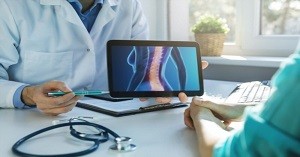Anterior Lumbar Interbody Fusion Newport Beach & Orange County, CA
Robert Louis, MD specializes in ALIF Surgery in Orange County
 Robert Louis, MD, your Orange County Neurosurgeon, performs Anterior Lumbar Interbody Fusion (ALIF) to remove herniated or degenerative discs through the abdomen. An incision of about three to five inches is made on the left side of the abdomen and the abdominal muscles are easily retracted to the side. The anterior abdominal muscle in the midline, also called rectus abdominis, does not run vertically, so it does not need to be cut. The abdominal contents, which lay inside a large sack, are also easily retracted to the side, allowing your spine surgeon access to the front of the spine without cutting through the abdomen.
Robert Louis, MD, your Orange County Neurosurgeon, performs Anterior Lumbar Interbody Fusion (ALIF) to remove herniated or degenerative discs through the abdomen. An incision of about three to five inches is made on the left side of the abdomen and the abdominal muscles are easily retracted to the side. The anterior abdominal muscle in the midline, also called rectus abdominis, does not run vertically, so it does not need to be cut. The abdominal contents, which lay inside a large sack, are also easily retracted to the side, allowing your spine surgeon access to the front of the spine without cutting through the abdomen.
After the damaged intervertebral disc is removed, a bone graft is inserted in the space to fuse together the bones above and below the disc space. This procedure is recommended if physical therapy or medications fail to decompress the spinal cord and nerve roots, stabilize the neck, and relieve painful symptoms. Disc disorders can cause spinal cord or nerve root impingement. Symptoms often include neck, shoulder, or arm pain with or without numbness, tingling, or weakness in the arms or hands. Patients typically go home the same day. Complete recovery may take up to four weeks.
Anterior Lumbar Interbody Fusion
Anterior lumbar interbody fusion is a procedure performed by approaching the spine through the abdomen. It involves the insertion of a bone graft into the disc space to help the vertebrae to fuse together. In case there is too much instability, the ALIF approach to spinal fusion may not provide enough stability. In such a situation, ALIF may be supplemented with a posterior approach (approaching the spine from the lower back) instrumentation and fusion for additional support to the fused level of the spine.
ALIF Procedure Newport Beach
The space between the vertebrae is empty after the affected disc is removed. To prevent the vertebrae from collapsing and rubbing together, a bone graft or bone graft substitute is inserted to create a spinal fusion and fill the open disc space. The bone graft and vertebrae are fixed in place with metal plates and screws for reinforcement. Following surgery, the body begins its natural healing process and new bone cells grow around the graft. After three to six months, the bone graft should join the two vertebrae and form one solid piece of bone. After fusion, the patient may notice some loss in the range of motion, which varies according to neck mobility before the fusion and the number of levels fused.
Types of Bone Graft
Autograft– The bone graph comes from the patient. Dr. Louis takes your own bone cells from the hip (iliac crest). This graft has a higher success rate of fusion because it has bone-growing cells and proteins. Harvesting a bone graft from your hip is done at the same time as spine surgery. The harvested bone is about a half-inch thick.
Allograft– The bone comes from a donor (cadaver) and is collected from people who have agreed to donate their organs after they die. This type of bone graft does not have bone-growing cells or proteins, yet it is readily available and eliminates the need to harvest bone from your hip. The center of the allograft is filled with shavings of living bone tissue taken from your spine during surgery.
Bone Graft Substitute– This type of graft is made of plastic, ceramic, or bioabsorbable substitute materials. Also called cages, bo graft material is filled with shavings of living bone tissue taken from your spine during surgery. For more information on ACDF, please call Dr. Louis at (949) 383-4185 or Contact Us.



